Submitted:
08 January 2024
Posted:
11 January 2024
You are already at the latest version
Abstract
Keywords:
1. Introduction
2. Materials and Methods
2.1. Subjects
| Subjects (n=16) | High level group (n=8) |
Low level group (n=8) |
|
| Age (year) | 24.7±3.25 | 23.75±1.98 | 25.38±2.6 |
| Height (cm) | 167.34±9.2 | 164.36±6.85 | 168.94±5.97 |
| Weight (kg) | 61±8.96 | 60.55±8.24 | 63.13±7.96 |
2.2. Prepare for Testing
2.3. Test Procedure
2.4. Data processing and Statistical analysis
3. Results
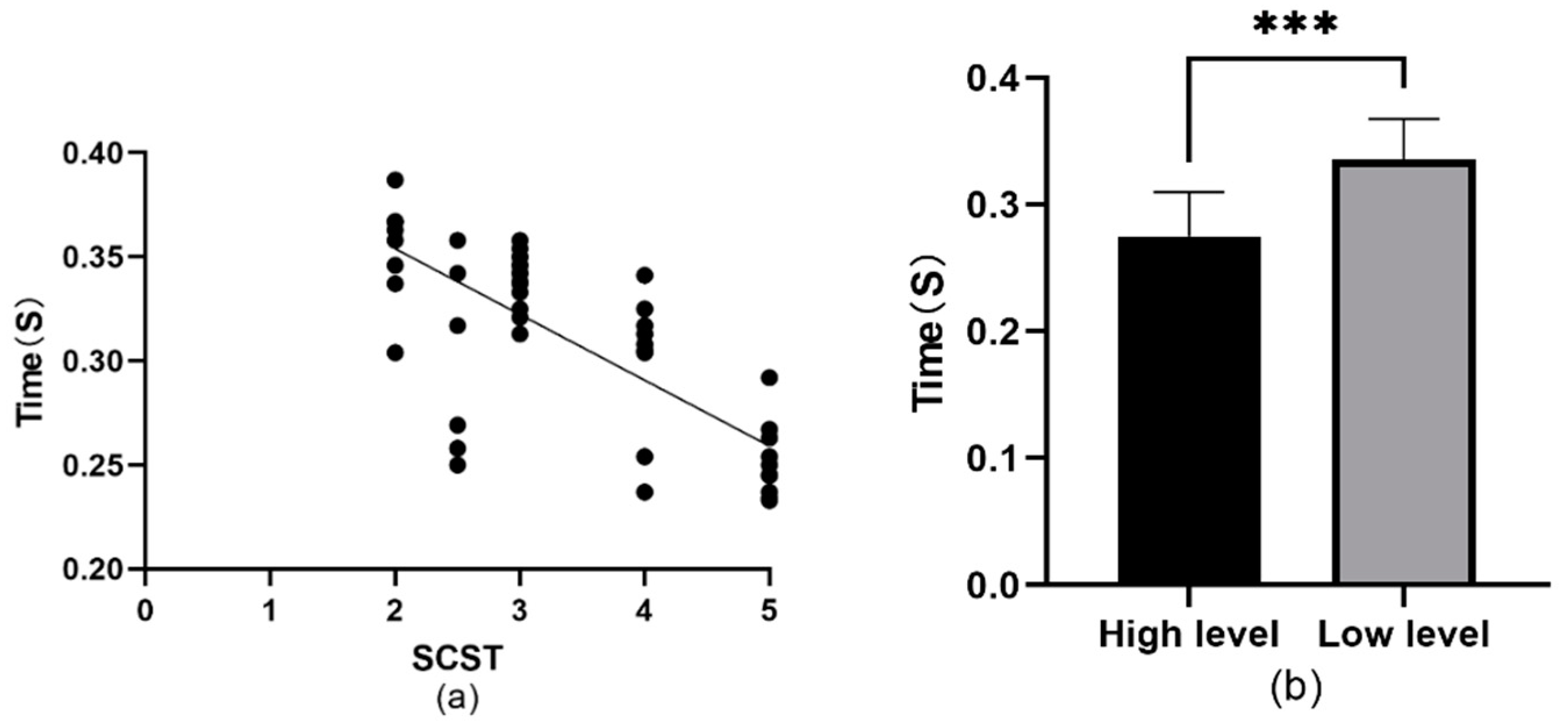
| SCST | ||||
| Varible | Axis | r | p | CI |
| Thigh | X | -0.6294 | <0.001*** | -0.785- -0.399 |
| Y | -0.3753 | 0.014* | -0.6097- 0.08055 | |
| Z | -0.5189 | <0.001*** | -0.7107- -0.2552 | |
| Shank | X | -0.5360 | <0.001*** | -0.7223- -0.2772 |
| Y | 0.06555 | 0.68 | -0.2432- 0.3623 | |
| Z | -0.5035 | <0.001*** | -0.7003- -0.2356 | |
| Foot | X | -0.6175 | <0.001*** | -0.7809- -0.3751 |
| Y | 0.1641 | 0.3181 | -0.1597- 0.456 | |
| Z | -0.4694 | 0.003** | -0.6837- -0.1806 | |
| SCST | ||||
| Varible | Axis | High level group | Low level group | p |
| Thigh | X | 6.19±2.28 | 9.16±2.52 | <0.001*** |
| Y | 5.51±1.37 | 7.09±2.59 | 0.023* | |
| Z | -0.26±0.7 | 0.93±2.64 | 0.06 | |
| Shank | X | 6.88±2.62 | 9.48±3.33 | 0.009** |
| Y | 6.53±1.67 | 6.14±2.14 | 0.526 | |
| Z | 4.06±2.1 | 6.5±3.91 | 0.018* | |
| Foot | X | 6.88±2.78 | 9.86±3.03 | 0.003** |
| Y | 6.18±2.07 | 5.56±0.9 | 0.33 | |
| Z | 3.08±2.66 | 5.74±5.17 | 0.52 | |
| SCST | ||||
| Muscle | Phase | r | p | CI |
| LRF | LTO-LKMF | -0.5413 | <0.001*** | -0.7259- -0.2842 |
| LKMF-LKME | -0.5852 | <0.001*** | -0.7532- -0.3456 | |
| LES | LTO-LKMF | 0.3018 | 0.196 | -0.1634- 0.6566 |
| LKMF-LKME | -0.0029 | 0.988 | -0.3405- 0.3358 | |
| LRA | LTO-LKMF | 0.4469 | 0.005** | 0.1485- 0.6708 |
| LKMF-LKME | -0.4615 | 0.004** | -0.6808- -0.1664 | |
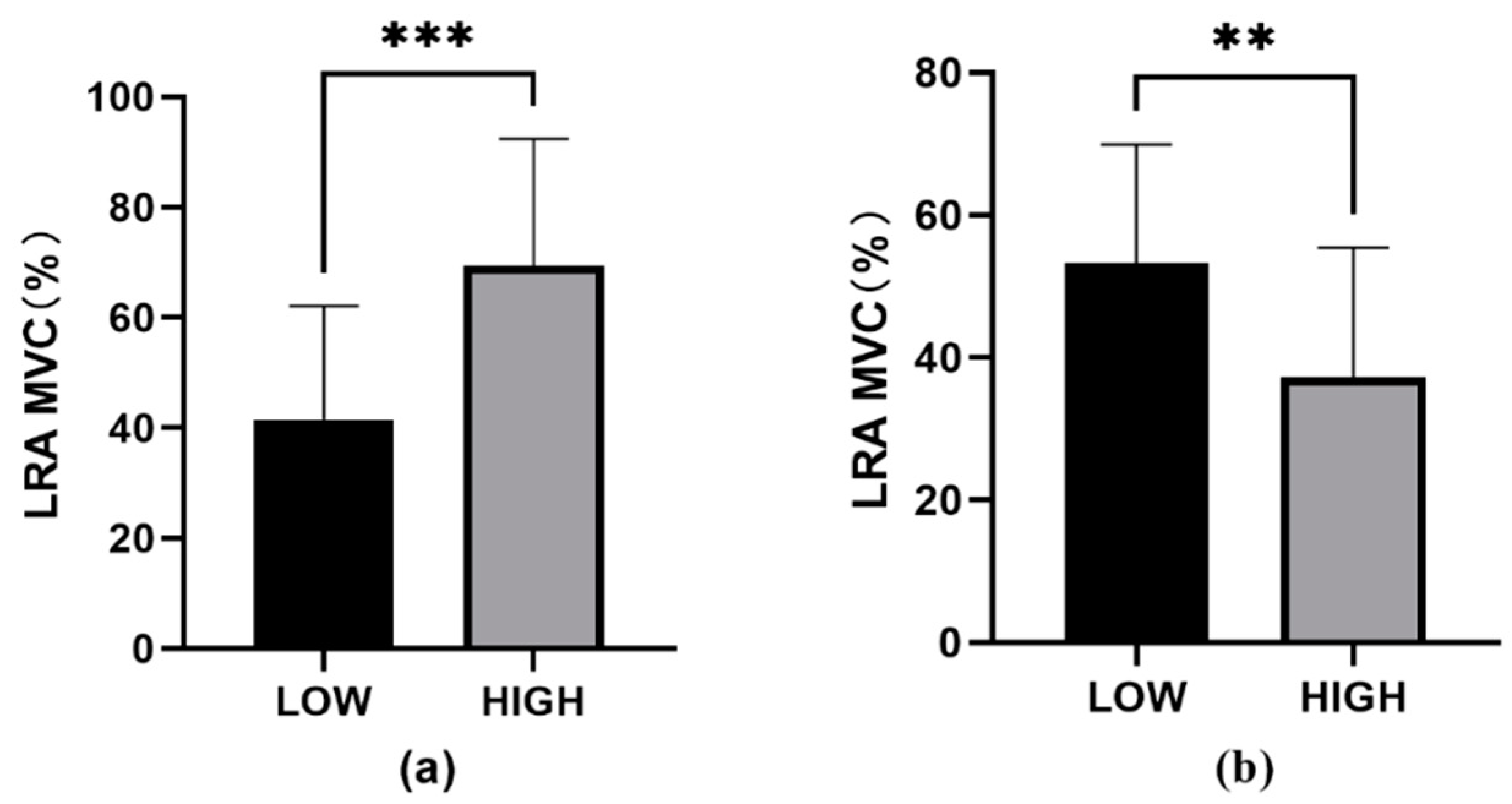
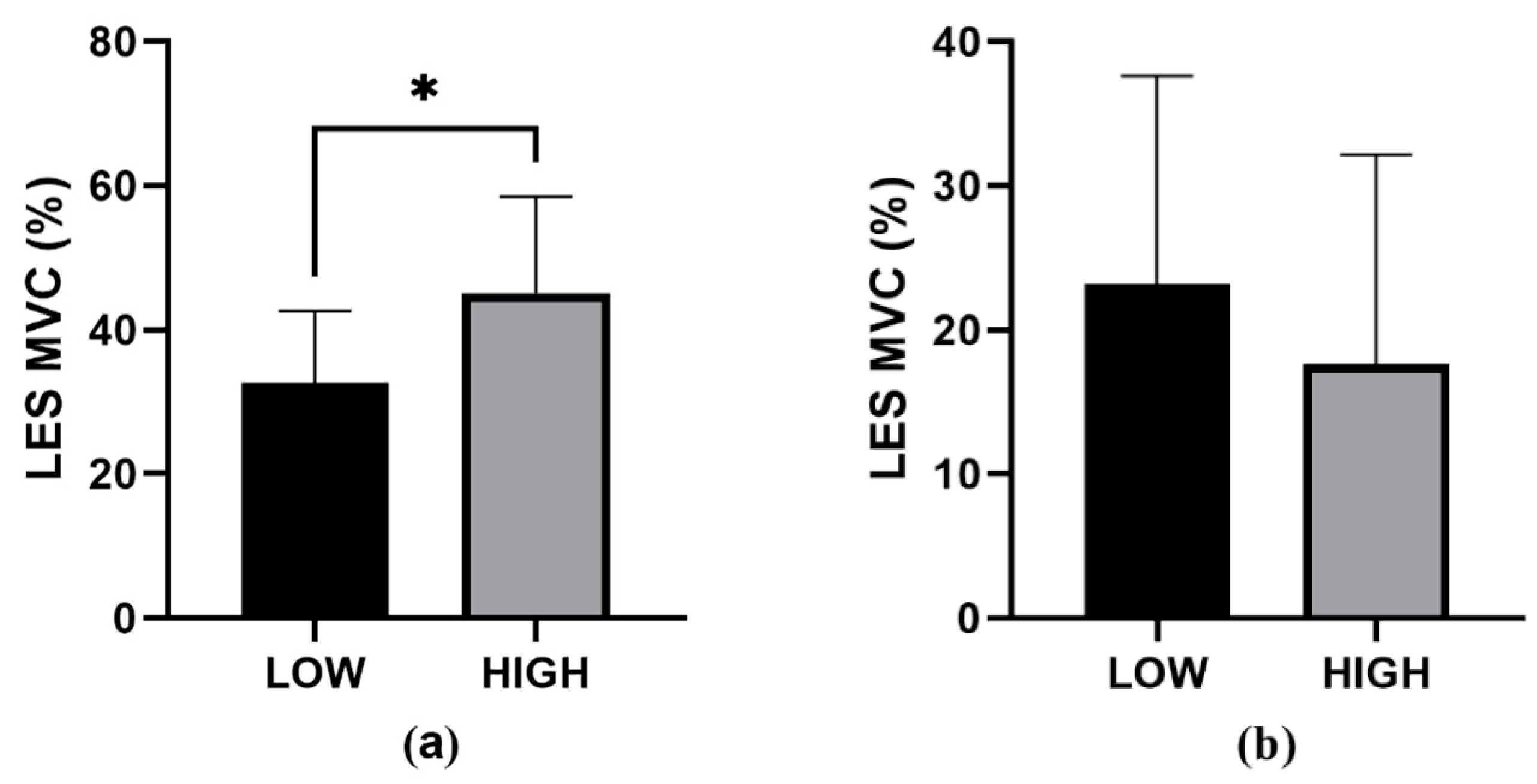
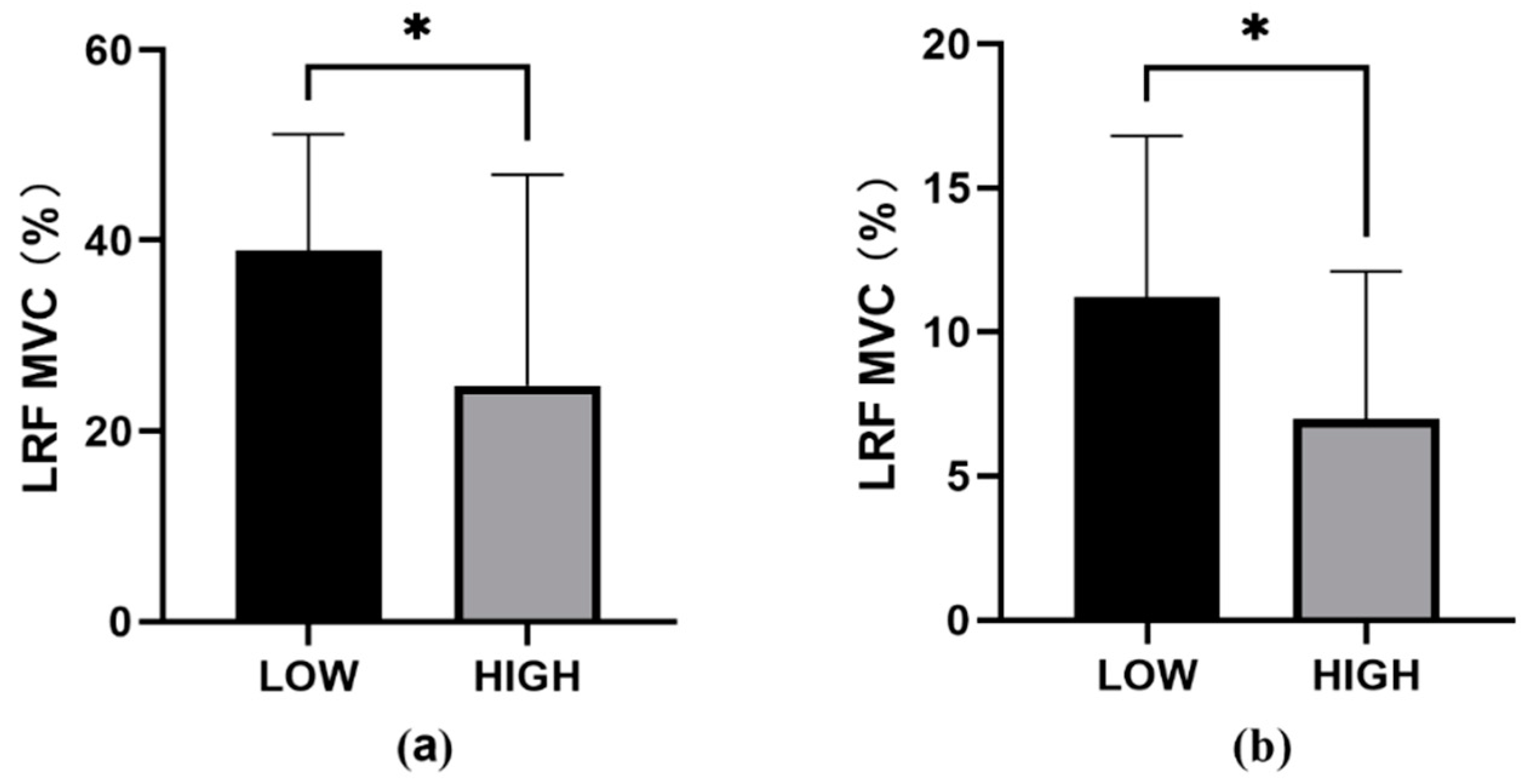
4. Discussion
5. Conclusions
References
- Ishac, K.; Eager, D.J.S. Evaluating martial arts punching kinematics using a vision and inertial sensing system. 2021, 21, 1948. [Google Scholar] [CrossRef]
- Kazemi, M.; Perri, G.; Soave, D.J.T.j.o.t.C.c.a. A profile of 2008 Olympic Taekwondo competitors. 2010, 54, 243.
- Chiodo, S.; Tessitore, A.; Cortis, C.; Lupo, C.; Ammendolia, A.; Iona, T.; Capranica, L.J.T.J.o.S.; Research, C. Effects of official Taekwondo competitions on all-out performances of elite athletes. 2011, 25, 334–339. [Google Scholar] [CrossRef]
- Falco, C.; Alvarez, O.; Castillo, I.; Estevan, I.; Martos, J.; Mugarra, F.; Iradi, A.J.J.o.b. Influence of the distance in a roundhouse kick's execution time and impact force in Taekwondo. 2009, 42, 242–248. [Google Scholar] [CrossRef]
- Estevan, I.; Jandacka, D.; Falco, C.J.J.o.s.s. Effect of stance position on kick performance in taekwondo. 2013, 31, 1815–1822. [Google Scholar] [CrossRef] [PubMed]
- Pozo, J.; Bastien, G.; Dierick, F. Execution time, kinetics, and kinematics of the mae-geri kick: comparison of national and international standard karate athletes. J Sports Sci 2011, 29, 1553–1561. [Google Scholar] [CrossRef]
- Estevan Torres, I.; Falcó Pérez, C.; Jandacka, D.; Freedman-Silvernail, J.J.J.O.H.K. Comparison of lower limb segments kinematics in taekwondo kick. an approach to the proximal to distal motion. 2015, 47, 41–49. [Google Scholar]
- Shirey, M.; Hurlbutt, M.; Johansen, N.; King, G.W.; Wilkinson, S.G.; Hoover, D.L.J.I.j.o.s.p.t. The influence of core musculature engagement on hip and knee kinematics in women during a single leg squat. 2012, 7, 1. [Google Scholar] [PubMed]
- Saeterbakken, A.H.; Fimland, M.; Navarsete, J.; Kroken, T.; van der Tillaar, R.J.J.N.P.P.R. Muscle activity, and the association between core strength, core endurance and core stability. 2015, 2, 28–34. [Google Scholar] [CrossRef]
- Oliva-Lozano, J.M.; Muyor, J.M.J.I.j.o.e.r.; health, p. Core muscle activity during physical fitness exercises: A systematic review. 2020; 17, 4306. [Google Scholar]
- Lee, J.; Jeong, K.-h.; Lee, H.-.; Shin, J.-y.; Choi, J.-l.; Kang, S.-b.; Lee, B.-H.J.P.t.r.s. Comparison of three different surface plank exercises on core muscle activity. 2016, 5, 29–33. [CrossRef]
- Borghuis, J.; Hof, A.L.; Lemmink, K.A.J.S.m. The importance of sensory-motor control in providing core stability: implications for measurement and training. 2008, 38, 893-916.
- Bahamonde, R.E.J.J.o.s.s. Changes in angular momentum during the tennis serve. 2000, 18, 579-592.
- Martin, C.; Kulpa, R.; Delamarche, P.; Bideau, B.J.S.B. Professional tennis players' serve: correlation between segmental angular momentums and ball velocity. 2013, 12, 2–14. [Google Scholar] [CrossRef]
- Ha, C.S. Kinematic Analysis of Taekwondo Narae-kick, Korean Society of Sports Science 2007, 16, 655-665.
- McGill, S.M.; Grenier, S.; Kavcic, N.; Cholewicki, J.J.J.o.e.; kinesiology. Coordination of muscle activity to assure stability of the lumbar spine. 2003, 13, 353–359. [CrossRef]
- McGill, S.M.J.E.; reviews, s.s. Low back stability: from formal description to issues for performance and rehabilitation. 2001, 29, 26-31.
- Brown, L.; Hastings, K.; Doyle, G.; Bruce-Low, S.; Galbraith, A.J.J.o.A.S. ; Conditioning. The effects of lower core resistance training on rear hand punching performance in professional boxers. 2021, 29, 15–24. [Google Scholar]
- Tack, C.J.S.; Journal, C. Evidence-based guidelines for strength and conditioning in mixed martial arts. 2013, 35, 79-92.
- Chan, E.W.M.; Hamid, M.S.A.; Nadzalan, A.M.; Hafiz, E.J.H.K.P.J. Abdominal muscle activation: an EMG study of the Sahrmann five-level core stability test. 2020, 40, 89–97. [Google Scholar] [CrossRef] [PubMed]
- Sahrmann, S. Movement System Impairment Syndromes of the Extremities, Cervical and Thoracic Spines; Elsevier Health Sciences, 2010. [Google Scholar]
- Leardini, A.; Biagi, F.; Merlo, A.; Belvedere, C.; Benedetti, M.G.J.C.B. Multi-segment trunk kinematics during locomotion and elementary exercises. 2011, 26, 562-571. [CrossRef]
- Barbero, M.; Merletti, R.; Rainoldi, A. Atlas of Muscle Innervation Zones: Understanding Surface Electromyography and Its Applications; Springer Science & Business Media, 2012. [Google Scholar]
- Haskins, I.N.; Prabhu, A.S.; Jensen, K.K.; Tastaldi, L.; Krpata, D.M.; Perez, A.J.; Tu, C.; Rosenblatt, S.; Rosen, M.J.J.S. Effect of transversus abdominis release on core stability: short-term results from a single institution. 2019, 165, 412-416. [CrossRef]
- Stanton, R.; Reaburn, P.R.; Humphries, B.J.T.J.o.S.; Research, C. The effect of short-term Swiss ball training on core stability and running economy. 2004, 18, 522-528.
- Aggarwal, A.; Kumar, S.; Madan, R.; Kumar, R.J.J.o.M.R. Relationship among different tests of evaluating low back core stability. 2011, 14, 1250004. [CrossRef]
- Ha, C.J.T.K.J.o.S.S. Kinematical analysis of narae Chagi in taekwondo. 2007, 16, 655-665.
- Hopkins, W.; Marshall, S.; Batterham, A.; Hanin, J.J.M.S.i.S.E. Progressive statistics for studies in sports medicine and exercise science. 2009, 41, 3. [CrossRef]
- Aggeloussis, N.; Gourgoulis, V.; Sertsou, M.; Giannakou, E.; Mavromatis, G.J.J.o.S.S. Repeatability of electromyographic waveforms during the Naeryo Chagi in taekwondo. 2007, 6, 6. [Google Scholar] [PubMed]
- Quinzi, F.; Bianchetti, A.; Felici, F.; Sbriccoli, P.J.J.o.E. Higher torque and muscle fibre conduction velocity of the Biceps Brachii in karate practitioners during isokinetic contractions. 2018, 40, 81–87. [Google Scholar] [CrossRef] [PubMed]
- Lee, B.; McGill, S.J.J.o.S.S. The effect of core training on distal limb performance during ballistic strike manoeuvres. 2017, 35, 1768-1780.
- Wirth, K.; Hartmann, H.; Mickel, C.; Szilvas, E.; Keiner, M.; Sander, A.J.S.m. Core stability in athletes: a critical analysis of current guidelines. 2017, 47, 401-414. [CrossRef]
- Sharrock, C.; Cropper, J.; Mostad, J.; Johnson, M.; Malone, T.J.I.j.o.s.p.t. A pilot study of core stability and athletic performance: is there a relationship? 2011, 6, 63.
- Lederman, E.J.J.o.b.; therapies, m. The myth of core stability. 2010, 14, 84-98.
- Kibler, W.B.; Press, J.; Sciascia, A.J.S.m. The role of core stability in athletic function. 2006, 36, 189-198. [CrossRef]
- Otani, T.; Hashimoto, K.; Miyamae, S.; Ueta, H.; Natsuhara, A.; Sakaguchi, M.; Kawakami, Y.; Lim, H.-O.; Takanishi, A.J.A.S. Upper-body control and mechanism of humanoids to compensate for angular momentum in the yaw direction based on human running. 2018, 8, 44. [Google Scholar] [CrossRef]
- Estevan, I.; Falco, C.; Elvira, J.L.; Vera-Garcia, F.J. Trunk and lower limb muscle activation in linear, circular and spin back kicks. 2015.
- Workman, J.C.; Docherty, D.; Parfrey, K.C.; Behm, D.G.J.T.J.o.S.; Research, C. Influence of pelvis position on the activation of abdominal and hip flexor muscles. 2008, 22, 1563–1569. [Google Scholar] [CrossRef] [PubMed]
- van der Hulst, M.; Vollenbroek-Hutten, M.M.; Rietman, J.S.; Hermens, H.J.J.J.o.E.; Kinesiology. Lumbar and abdominal muscle activity during walking in subjects with chronic low back pain: support of the “guarding” hypothesis? 2010, 20, 31-38.
- Escamilla, R.F.; Lewis, C.; Bell, D.; Bramblet, G.; Daffron, J.; Lambert, S.; Pecson, A.; Imamura, R.; Paulos, L.; Andrews, J.R.J.J.o.o.; et al. Core muscle activation during Swiss ball and traditional abdominal exercises. 2010, 40, 265-276.
- Kim, Y.K.; Kim, Y.H.; Im, S.J.J.J.o.S.S.; Medicine. Inter-joint coordination in producing kicking velocity of Taekwondo kicks. 2011, 10, 31-38.
- Lindle, R.; Metter, E.; Lynch, N.; Fleg, J.v.; Fozard, J.; Tobin, J.; Roy, T.; Hurley, B.J.J.o.a.p. Age and gender comparisons of muscle strength in 654 women and men aged 20–93 yr. 1997, 83, 1581-1587. [CrossRef]
- Kim, J.-W.; Kwon, M.-S.; Yenuga, S.S.; Kwon, Y.-H.J.S.B. The effects of target distance on pivot hip, trunk, pelvis, and kicking leg kinematics in Taekwondo roundhouse kicks. 2010, 9, 98-114. [CrossRef]
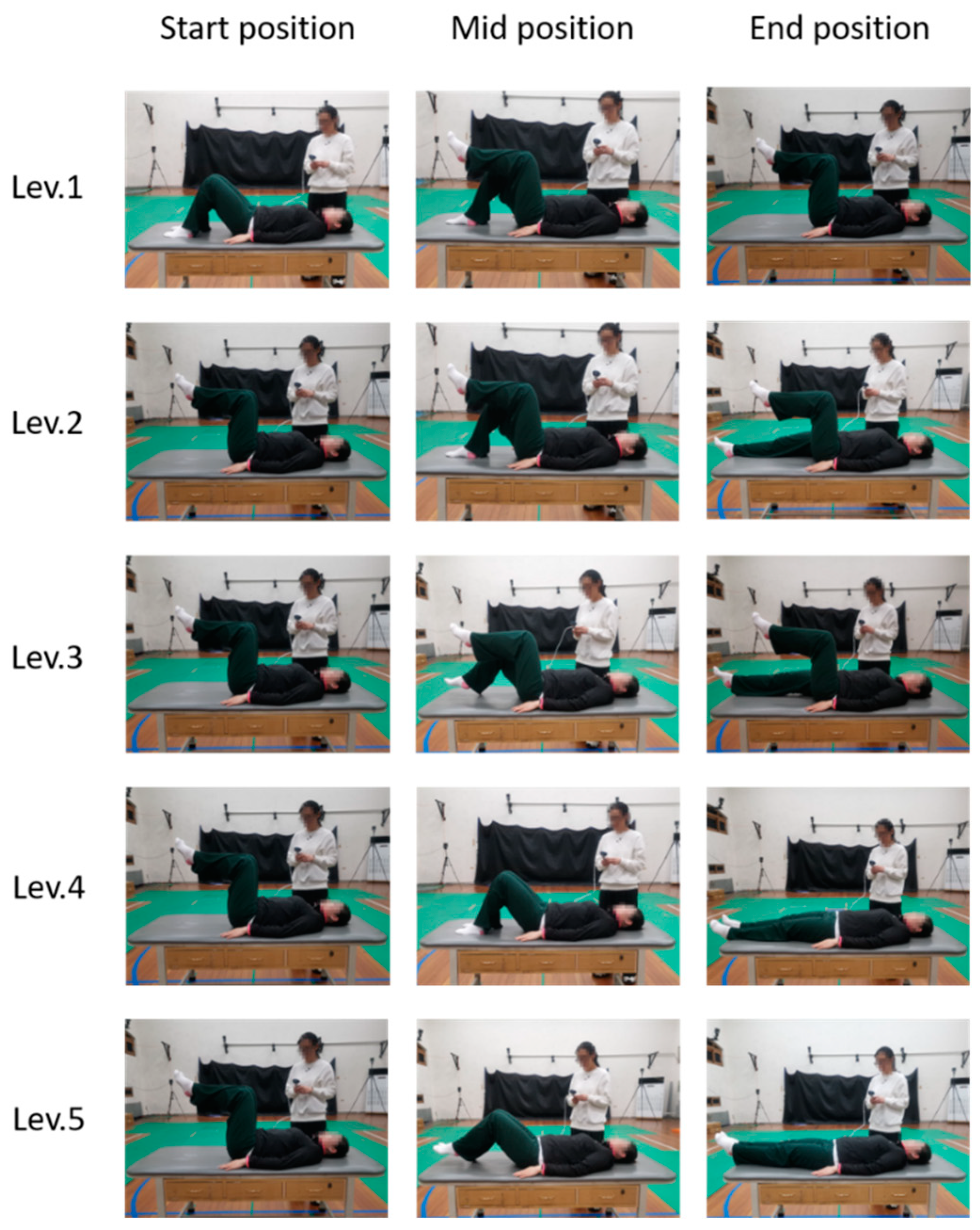

Disclaimer/Publisher’s Note: The statements, opinions and data contained in all publications are solely those of the individual author(s) and contributor(s) and not of MDPI and/or the editor(s). MDPI and/or the editor(s) disclaim responsibility for any injury to people or property resulting from any ideas, methods, instructions or products referred to in the content. |
© 2024 by the authors. Licensee MDPI, Basel, Switzerland. This article is an open access article distributed under the terms and conditions of the Creative Commons Attribution (CC BY) license (http://creativecommons.org/licenses/by/4.0/).





